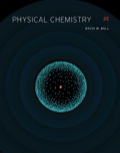
Interpretation:
The expected symmetry pairings of the nuclear and rotational wavefunctions is to be predicted.
Concept introduction:
The symmetry pairings of the nuclear and rotational wavefunctions is given as follows:
Answer to Problem 18.33E
The expected symmetry pairings of the nuclear and rotational wavefunctions are,
Explanation of Solution
It is given that the diatomic oxygen has an antisymmetric ground electronic state. The oxygen nuclei are bosons
The symmetry pairings of the nuclear and rotational wavefunctions is given as follows:
Substitute
For even values of
Substitute
Substitute
Substitute
Hence, the expected symmetry pairings of the nuclear and rotational wavefunctions are,
The expected symmetry pairings of the nuclear and rotational wavefunctions are,
Want to see more full solutions like this?
Chapter 18 Solutions
Physical Chemistry
- What is the physical explanation of the difference between a particle having the 3-D rotational wavefunction 3,2 and an identical particle having the wavefunction 3,2?arrow_forwardWrite a Slater determinant for the lithide ion, Li.arrow_forwardWhat are the degeneracies of the H atom wavefunctions when spin is accounted for? Give a general formula.arrow_forward
- The rotation of a 1H127I molecule can be pictured as the orbital motion of the hydrogen atom at adistance of 160 pm from the stationary iodine atom. Suppose that the molecule rotates only in a plane.Calculate the minimum energy needed to excite the molecule into rotation. What, apart from 0, is theminimum angular momentum of the molecule?arrow_forwardAn HCl molecule initially in the (v, J) = (0, 2) quantum state can absorb infrared photons. What are the two most likely final quantum states after absorbing an infrared photon? Calculate the energy of the infrared photonabsorbed for each of these transitions. Can it also absorb a microwave photon? If yes, calculate that photon energy also. The rotational constant of HCl is 10 cm-1 and its vibrational frequency is 2990 cm-1.arrow_forwardThe nucleus of a boron-11 atom has a spin (s) quantum number of 3/2. Calculate the magnitude of the spin vector as well as the possible values it can take for the z-component of the spin vector? Is boron-11 a boson or fermion?arrow_forward
- 4h The chlorophylls that participate in photosynthesis and the haem groups of cytochromes are derived from the porphine dianine group (1), which belongs to the D point group. The ground electronic state is A and the lowest-lying excited state is E. Is a photon-induced transition allowed from the ground state to the excited state? Explain your answer. u : NH (1) HN:arrow_forwardRotational spectra are affected slightly by the fact that different isotopes have different masses. Suppose a sample of the common isotope 1H35Cl is changed to 1H37Cl. (a) By what fraction is the molecule’s rotational inertia different? (The bond length is 0.127 nm in each case.) (b) What is the change in energy of theℓ = 1 to theℓ = 0 transition if the isotope is changed?arrow_forward8. Calculate the moment of inertia and the energy in the J = 1 rotational state for ¹H₂ in which the bond length of ¹H₂ is 74.6 pm. The atomic mass of ¹H is 1.0078 u.arrow_forward
- What are the atomic term symbols for an electronic configuration of s2p?arrow_forwardWhat states of (i) benzene, (ii) naphthalene may be reached by electric dipole transitions from their (totally symmetrical) ground states?arrow_forwardDetermine the atomic term symbols for the allowed atomic states of p3 resulting from the coupling of orbital and spin angular momentums.arrow_forward
 Physical ChemistryChemistryISBN:9781133958437Author:Ball, David W. (david Warren), BAER, TomasPublisher:Wadsworth Cengage Learning,
Physical ChemistryChemistryISBN:9781133958437Author:Ball, David W. (david Warren), BAER, TomasPublisher:Wadsworth Cengage Learning, Principles of Modern ChemistryChemistryISBN:9781305079113Author:David W. Oxtoby, H. Pat Gillis, Laurie J. ButlerPublisher:Cengage Learning
Principles of Modern ChemistryChemistryISBN:9781305079113Author:David W. Oxtoby, H. Pat Gillis, Laurie J. ButlerPublisher:Cengage Learning

